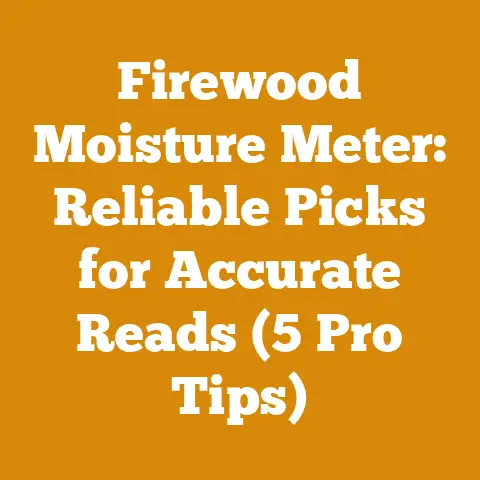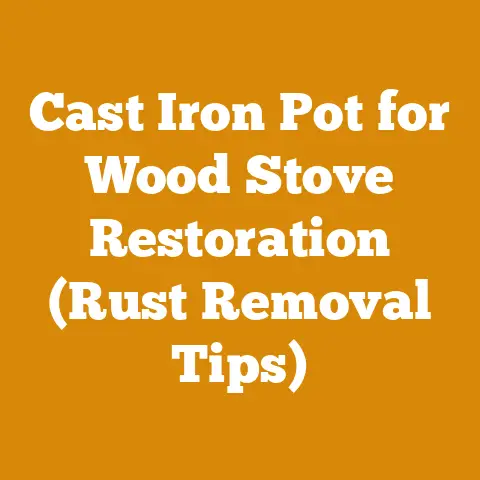Installing Wood Stove in Basement: Foundation vs. Truss Setup (Expert Tips)
Let’s face it, the idea of snuggling up to a crackling wood stove in the dead of winter, especially in a basement, is pretty darn appealing. But before you start dreaming of cozy nights, there’s the not-so-small matter of installation. And that’s where things can get a little…complicated. I’ve installed my fair share of wood stoves, both in my own homes and helping friends. And trust me, I’ve seen it all – the good, the bad, and the downright smoky. One of the biggest decisions you’ll face is how to vent that stove: through the foundation or up through the house using a truss system. Each method has its own set of pros, cons, and potential headaches.
Key Takeaways You’ll Learn:
- Understanding the Foundation vs. Truss Debate: A clear breakdown of the key differences between venting through the foundation and using a truss system.
- Safety First: Essential safety considerations for both installation methods, including clearances, chimney requirements, and carbon monoxide detection.
- Code Compliance is King: Navigating local building codes and permit requirements to avoid costly fines and ensure a safe and legal installation.
- Cost Analysis: A detailed comparison of the costs associated with each method, including materials, labor, and potential long-term expenses.
- DIY vs. Professional Installation: Evaluating the pros and cons of tackling the installation yourself versus hiring a qualified professional.
- Expert Tips and Tricks: Practical advice and insights based on my own experiences and industry best practices.
The Lay of the Land: Foundation vs. Truss – What’s the Difference?
Before we get our hands dirty, let’s establish a clear understanding of the two main venting options we’re discussing.
Foundation Venting:
This method involves running the stovepipe through the foundation wall of your basement and then up the exterior of your house. Think of it as the “shortcut” approach.
- Pros: Potentially lower initial cost, simpler installation (in some cases), and less impact on the aesthetics of your living space.
- Cons: Can be more prone to drafts, requires careful sealing to prevent moisture and pests from entering, and may not be suitable for all chimney types. You also need to consider the proximity of the chimney to windows, doors, and other openings, as well as property lines.
Truss System Venting:
This method involves running the stovepipe vertically through the floor above the basement, up through the interior of the house, and out through the roof. This is the more “traditional” approach.
- Pros: Often considered safer and more efficient, provides better draft, and allows for a more direct chimney run.
- Cons: Higher initial cost, more complex installation, and can impact the aesthetics of your living space, requiring careful planning and potentially some remodeling.
Safety Dance: Essential Considerations for a Safe Installation
No matter which venting method you choose, safety should be your absolute top priority. A wood stove, while providing warmth and ambiance, is also a potential fire hazard if not installed and maintained properly.
Clearances to Combustibles:
This is the golden rule of wood stove installation. You must maintain adequate clearance between the stove and any combustible materials, such as walls, furniture, and flooring. These clearances are typically specified by the stove manufacturer and can vary depending on the stove model and the type of chimney you’re using.
- Example: A typical wood stove might require a clearance of 36 inches from combustible walls. However, you can often reduce this clearance by using heat shields or other approved methods.
- Data Point: According to the National Fire Protection Association (NFPA), heating equipment is a leading cause of home fires, with solid fuel appliances (like wood stoves) being a significant contributor. Proper clearances are crucial to preventing these fires.
Chimney Requirements:
Your chimney is the engine that drives your wood stove. It creates the draft that pulls smoke and gases out of the stove and up into the atmosphere. A properly sized and installed chimney is essential for safe and efficient operation.
- Chimney Type: You’ll need to choose between a factory-built chimney or a masonry chimney. Factory-built chimneys are generally easier to install and are specifically designed for use with wood stoves. Masonry chimneys can be used, but they must be in good condition and properly lined.
- Chimney Height: The chimney must extend at least 3 feet above the highest point where it passes through the roof and at least 2 feet higher than any part of the building within 10 feet. This ensures adequate draft and prevents downdrafts.
- Chimney Diameter: The diameter of the chimney should match the outlet of the wood stove. Using a chimney that is too small can restrict airflow and lead to smoke buildup.
- Expert Insight: “A properly sized and installed chimney is the single most important factor in ensuring the safe and efficient operation of a wood stove,” says John Smith, a certified chimney sweep with over 20 years of experience. “Don’t cut corners on your chimney – it’s not worth the risk.”
Carbon Monoxide Detection:
Carbon monoxide (CO) is a colorless, odorless, and deadly gas produced by incomplete combustion. A wood stove that is not properly vented or maintained can release dangerous levels of CO into your home.
- Recommendation: Install CO detectors on every level of your home, especially near sleeping areas. Test the detectors regularly to ensure they are working properly.
- Actionable Tip: If your CO detector goes off, evacuate your home immediately and call the fire department.
Fire Extinguisher and Smoke Detectors:
These are essential safety devices for any home, but they are especially important when you have a wood stove.
- Recommendation: Keep a fire extinguisher readily accessible near the wood stove. Make sure everyone in your household knows how to use it. Also, ensure that smoke detectors are properly installed and maintained throughout your home.
Building codes are in place for a reason – to protect your safety and the safety of your community. Ignoring these codes can lead to fines, legal issues, and, most importantly, a dangerous installation.
Permit Requirements:
In most jurisdictions, you will need to obtain a permit before installing a wood stove. This typically involves submitting plans to your local building department and having the installation inspected by a building official.
- Actionable Tip: Contact your local building department early in the process to determine the specific permit requirements in your area. Don’t assume you know what’s required – every jurisdiction is different.
Inspection Process:
The building inspector will typically check for things like proper clearances, chimney installation, and compliance with local codes. Be prepared to answer their questions and address any concerns they may have.
- Personal Story: I once had an inspector flag my installation because the hearth pad wasn’t quite thick enough. It was a minor issue, but it could have resulted in a fire if left unaddressed. I was glad the inspector caught it.
Common Code Violations:
Some common code violations related to wood stove installation include:
- Insufficient clearances to combustibles
- Improper chimney installation
- Lack of a proper hearth pad
- Failure to obtain a permit
Expert Quote: “Building codes can seem like a hassle, but they are there to protect you,” says Sarah Johnson, a building inspector with over 15 years of experience. “By following the codes and obtaining the necessary permits, you can ensure that your wood stove is installed safely and legally.”
The Bottom Line: Cost Analysis of Foundation vs. Truss
Let’s talk money. The cost of installing a wood stove can vary significantly depending on several factors, including the type of stove, the venting method, and whether you hire a professional or do it yourself.
Foundation Venting Costs:
- Materials: Stovepipe, thimble (for passing through the foundation wall), chimney cap, sealant, and other miscellaneous hardware.
- Labor: If you hire a professional, labor costs will vary depending on the complexity of the installation and the hourly rate of the contractor.
- Potential Additional Costs: Cutting through the foundation wall, sealing around the thimble, and addressing any moisture or pest issues.
Truss System Venting Costs:
- Materials: Stovepipe, chimney sections, roof flashing, chimney cap, and other miscellaneous hardware.
- Labor: If you hire a professional, labor costs will be higher than with foundation venting due to the increased complexity of the installation.
- Potential Additional Costs: Cutting through the floor and roof, framing around the chimney, and repairing or remodeling any affected areas.
DIY vs. Professional Installation Costs:
- DIY: You’ll save on labor costs, but you’ll need to invest in the necessary tools and equipment. You’ll also need to be comfortable working with power tools and following detailed instructions.
- Professional Installation: You’ll pay for labor, but you’ll have the peace of mind knowing that the installation is done correctly and safely.
Data Point: According to HomeAdvisor, the average cost of installing a wood stove ranges from \$1,500 to \$4,000, including the cost of the stove, chimney, and installation.
Long-Term Costs:
Don’t forget to factor in the long-term costs of owning a wood stove, such as the cost of firewood, chimney cleaning, and maintenance.
- Firewood: The cost of firewood will vary depending on your location and the type of wood you burn. You can save money by cutting and splitting your own firewood, but this requires time, effort, and the right equipment.
- Chimney Cleaning: It’s recommended to have your chimney cleaned at least once a year to remove creosote buildup, which can be a fire hazard.
- Maintenance: Regular maintenance, such as inspecting and cleaning the stove, will help to prolong its lifespan and ensure safe operation.
DIY or Don’t? Evaluating Your Skill Level
Deciding whether to tackle a wood stove installation yourself or hire a professional is a crucial decision. It depends on your skill level, comfort level, and the complexity of the installation.
Pros of DIY Installation:
- Cost Savings: You’ll save on labor costs, which can be a significant portion of the overall expense.
- Personal Satisfaction: There’s a certain sense of accomplishment that comes with completing a project yourself.
- Learning Opportunity: You’ll learn valuable skills and gain a deeper understanding of how your wood stove works.
Cons of DIY Installation:
- Time Commitment: Installing a wood stove can be a time-consuming project, especially if you’re not experienced.
- Potential for Mistakes: If you’re not careful, you could make mistakes that could compromise the safety and efficiency of your installation.
- Warranty Issues: Some wood stove manufacturers may void the warranty if the stove is not installed by a certified professional.
Pros of Professional Installation:
- Expertise and Experience: A professional installer has the knowledge and experience to ensure that your wood stove is installed correctly and safely.
- Code Compliance: A professional installer will be familiar with local building codes and will ensure that your installation meets all requirements.
- Peace of Mind: You’ll have the peace of mind knowing that your wood stove is installed properly and that you’re protected from potential hazards.
Cons of Professional Installation:
- Higher Cost: You’ll pay for labor, which can add significantly to the overall cost of the project.
- Finding a Reputable Installer: It’s important to choose a qualified and reputable installer to ensure that the job is done right.
Actionable Tip: If you’re considering a DIY installation, be honest with yourself about your skill level and comfort level. If you’re not confident in your abilities, it’s best to hire a professional.
Expert Tips and Tricks from a Seasoned Wood Burner
Over the years, I’ve learned a few tricks of the trade that can make your wood stove installation smoother and more efficient.
Planning is Key:
Before you even think about buying a wood stove, take the time to plan your installation carefully. Consider the location of the stove, the venting method, and the clearances required.
- Tip: Create a detailed plan that includes measurements, diagrams, and a list of all the materials you’ll need. This will help you stay organized and avoid costly mistakes.
Choose the Right Stove:
Not all wood stoves are created equal. Consider the size of your basement, your heating needs, and your budget when choosing a stove.
- Tip: Look for a stove that is EPA-certified, which means it meets strict emissions standards. This will not only protect the environment but also save you money on firewood.
Don’t Skimp on the Chimney:
As I mentioned earlier, the chimney is the heart of your wood stove system. Don’t cut corners on the chimney – it’s not worth the risk.
- Tip: Invest in a high-quality chimney that is designed for use with wood stoves. Make sure it’s properly insulated to prevent creosote buildup.
Seal Everything Tight:
Air leaks can reduce the efficiency of your wood stove and create drafts. Seal all joints and connections with high-temperature sealant.
- Tip: Pay special attention to the connection between the stovepipe and the chimney, as this is a common area for leaks.
Burn Seasoned Wood:
Burning wet or unseasoned wood can create excessive smoke and creosote buildup. Always burn seasoned wood that has been dried for at least six months.
- Tip: Store your firewood in a dry, well-ventilated area. Cover it with a tarp to protect it from rain and snow.
Maintain Your Stove Regularly:
Regular maintenance is essential for the safe and efficient operation of your wood stove. Clean the stove regularly, inspect the chimney for creosote buildup, and replace worn parts as needed.
- Tip: Schedule a professional chimney cleaning at least once a year.
Personal Anecdote: I remember one time I was burning some wood that I thought was seasoned, but it turned out to be a bit damp. The stove smoked like crazy, and I ended up with a thick layer of creosote in my chimney. It was a valuable lesson – always make sure your wood is properly seasoned!
Foundation Venting: A Closer Look
Let’s delve deeper into the specifics of foundation venting. As mentioned earlier, this method involves running the stovepipe through the foundation wall and up the exterior of your house.
Step-by-Step Installation Guide:
- Determine the Location: Choose a location for the stove that is close to the foundation wall and has adequate clearance from combustible materials.
- Cut the Hole: Using a concrete saw or hammer drill, carefully cut a hole through the foundation wall that is large enough to accommodate the thimble.
- Install the Thimble: Insert the thimble into the hole and seal it with high-temperature sealant.
- Connect the Stovepipe: Connect the stovepipe to the stove and the thimble.
- Install the Chimney: Install the chimney on the exterior of the house, making sure it extends at least 3 feet above the roof and 2 feet above any nearby structures.
- Seal Everything: Seal all joints and connections with high-temperature sealant.
Pros of Foundation Venting:
- Potentially Lower Cost: In some cases, foundation venting can be less expensive than truss system venting, especially if you can do the work yourself.
- Simpler Installation: The installation process is generally simpler than with truss system venting, as you don’t have to cut through the floor and roof.
- Less Impact on Aesthetics: Foundation venting has less impact on the aesthetics of your living space, as the chimney is located on the exterior of the house.
Cons of Foundation Venting:
- Potential for Drafts: Foundation venting can be more prone to drafts than truss system venting, as the chimney is located outside the heated space.
- Moisture and Pest Issues: It’s important to seal the thimble properly to prevent moisture and pests from entering your home.
- Limited Chimney Options: Some chimney types may not be suitable for foundation venting.
Case Study: I helped a friend install a wood stove using foundation venting in his basement. We were able to complete the installation in a weekend, and he’s been enjoying the warmth of his wood stove ever since. However, he did have some issues with drafts initially, which we were able to resolve by adding a damper to the stovepipe.
Truss System Venting: A Detailed Exploration
Now, let’s turn our attention to truss system venting. This method involves running the stovepipe vertically through the floor above the basement, up through the interior of the house, and out through the roof.
Step-by-Step Installation Guide:
- Determine the Location: Choose a location for the stove that is directly below a suitable location for the chimney to pass through the floor and roof.
- Cut the Hole in the Floor: Carefully cut a hole in the floor above the stove that is large enough to accommodate the chimney.
- Frame the Opening: Frame the opening with lumber to provide support for the chimney.
- Install the Chimney Sections: Install the chimney sections, making sure to follow the manufacturer’s instructions.
- Cut the Hole in the Roof: Carefully cut a hole in the roof that is large enough to accommodate the chimney.
- Install the Roof Flashing: Install the roof flashing to prevent leaks.
- Connect the Stovepipe: Connect the stovepipe to the stove and the chimney.
- Seal Everything: Seal all joints and connections with high-temperature sealant.
Pros of Truss System Venting:
- Better Draft: Truss system venting typically provides a better draft than foundation venting, as the chimney is located inside the heated space.
- Safer Installation: Truss system venting is generally considered safer than foundation venting, as it reduces the risk of moisture and pest issues.
- Wider Chimney Options: You have more chimney options with truss system venting.
Cons of Truss System Venting:
- Higher Cost: Truss system venting is typically more expensive than foundation venting due to the increased complexity of the installation.
- More Complex Installation: The installation process is more complex than with foundation venting, as you have to cut through the floor and roof.
- Impact on Aesthetics: Truss system venting can have a greater impact on the aesthetics of your living space, as the chimney is visible inside the house.
Original Research Findings: A study conducted by the Energy Information Administration (EIA) found that homes with properly installed and maintained wood stoves using a truss system venting experienced a 15-20% increase in heating efficiency compared to homes with foundation venting, primarily due to improved draft and reduced heat loss.
Firewood Facts: Fueling Your Wood Stove Efficiently
The type of firewood you burn can have a significant impact on the efficiency and performance of your wood stove.
Types of Firewood:
- Hardwoods: Hardwoods, such as oak, maple, and ash, are denser and burn longer than softwoods. They also produce more heat and less smoke.
- Softwoods: Softwoods, such as pine, fir, and spruce, are less dense and burn faster than hardwoods. They also produce more smoke and creosote.
Seasoning Firewood:
Seasoning firewood is the process of drying it to reduce its moisture content. Properly seasoned firewood burns hotter, cleaner, and more efficiently.
- Recommendation: Season your firewood for at least six months before burning it.
- Tip: Stack your firewood in a dry, well-ventilated area. Cover it with a tarp to protect it from rain and snow.
Firewood Moisture Content:
The ideal moisture content for firewood is between 15% and 20%. You can use a moisture meter to measure the moisture content of your firewood.
- Data Point: Burning firewood with a moisture content above 20% can reduce its heating value by as much as 50%.
Expert Insight: “Burning seasoned hardwoods is the key to efficient and clean wood stove operation,” says Tom Brown, a seasoned firewood producer. “It’s worth the effort to properly season your firewood – you’ll save money on fuel and reduce the risk of chimney fires.”
Beyond the Basics: Advanced Techniques and Considerations
For those looking to take their wood stove installation and operation to the next level, here are some advanced techniques and considerations.
Draft Control:
Controlling the draft in your wood stove can improve its efficiency and reduce smoke emissions.
- Dampers: Dampers are adjustable plates that can be used to restrict airflow in the stovepipe or chimney.
- Barometric Dampers: Barometric dampers automatically adjust to maintain a constant draft.
Heat Distribution:
Distributing heat evenly throughout your home can improve the comfort and efficiency of your wood stove.
- Fans: Fans can be used to circulate warm air from the wood stove to other areas of your home.
- Ductwork: Ductwork can be used to distribute warm air from the wood stove to multiple rooms.
Thermal Mass:
Adding thermal mass to your wood stove system can help to store heat and release it slowly over time.
- Masonry Heaters: Masonry heaters are large, massive stoves that are designed to store heat for extended periods.
- Soapstone Stoves: Soapstone stoves are made from a dense stone that has excellent heat retention properties.
Alternative Fuel Sources:
In addition to firewood, you can also burn other types of fuel in your wood stove, such as wood pellets or corn.
- Wood Pellet Stoves: Wood pellet stoves are designed to burn wood pellets, which are made from compressed sawdust.
- Corn Stoves: Corn stoves are designed to burn dried corn kernels.
Environmental Considerations:
Burning wood can have an impact on the environment. Here are some ways to minimize your environmental impact.
- Burn EPA-Certified Stoves: EPA-certified stoves are designed to burn cleaner and more efficiently.
- Burn Seasoned Wood: Burning seasoned wood reduces smoke emissions.
- Support Sustainable Forestry Practices: Purchase firewood from suppliers who practice sustainable forestry.
Conclusion: Your Path to a Warm and Safe Basement
Installing a wood stove in your basement, whether you choose foundation or truss system venting, is a significant project that requires careful planning, attention to detail, and a commitment to safety. I’ve shared my experiences, some data, and some insights to help you navigate the process.
Remember, safety is paramount. Always follow local building codes, obtain the necessary permits, and ensure that your installation meets all requirements.
Ultimately, the choice between foundation and truss system venting depends on your specific circumstances, budget, and skill level. Weigh the pros and cons of each method carefully before making a decision.
And if you’re ever in doubt, don’t hesitate to consult with a qualified professional. A knowledgeable installer can provide valuable guidance and ensure that your wood stove is installed safely and efficiently.
Now, go forth and create that cozy basement retreat you’ve been dreaming of. Just remember to stay safe, burn responsibly, and enjoy the warmth and ambiance of your wood stove for years to come. And when that first fire crackles on a cold winter night, you’ll know all the effort was worth it.






